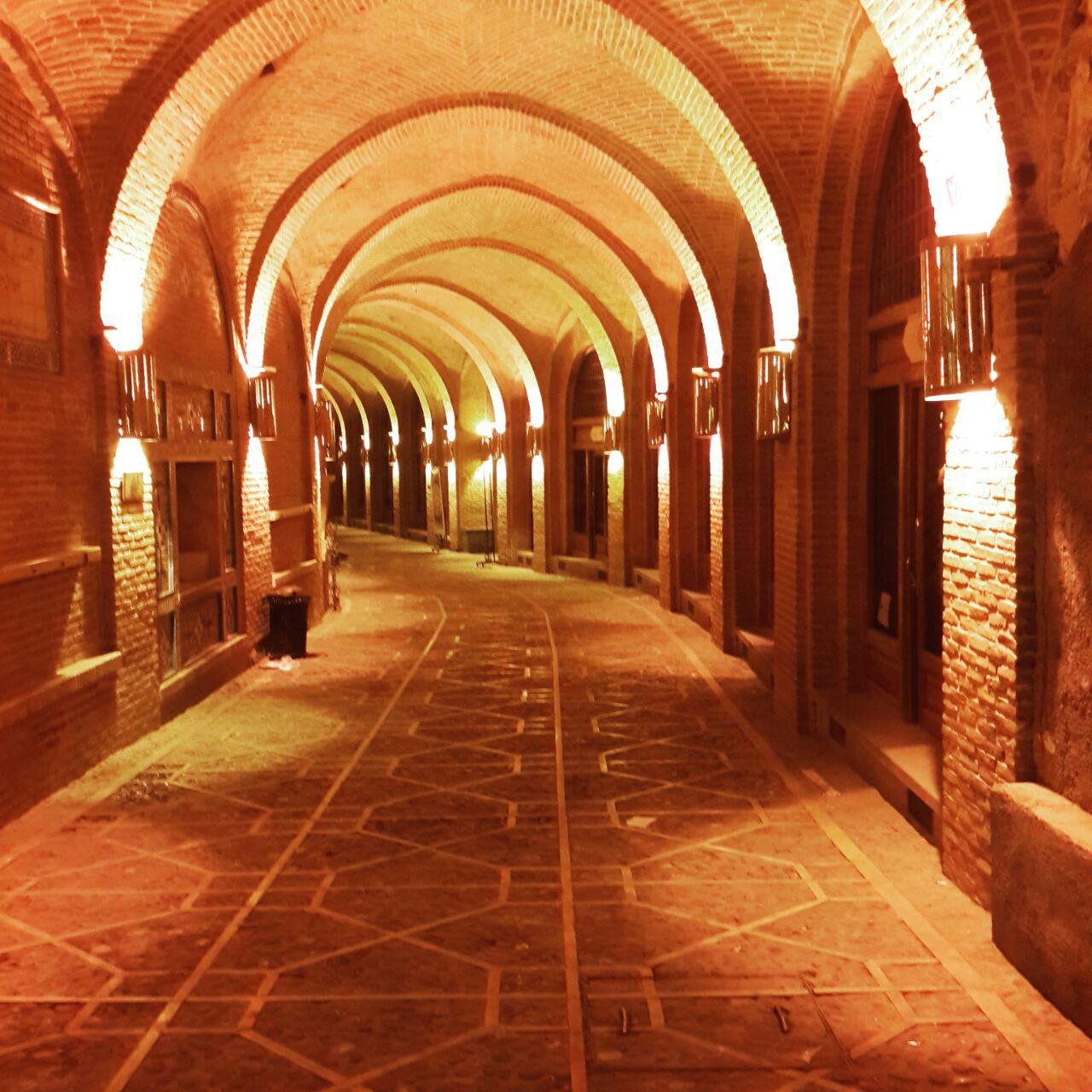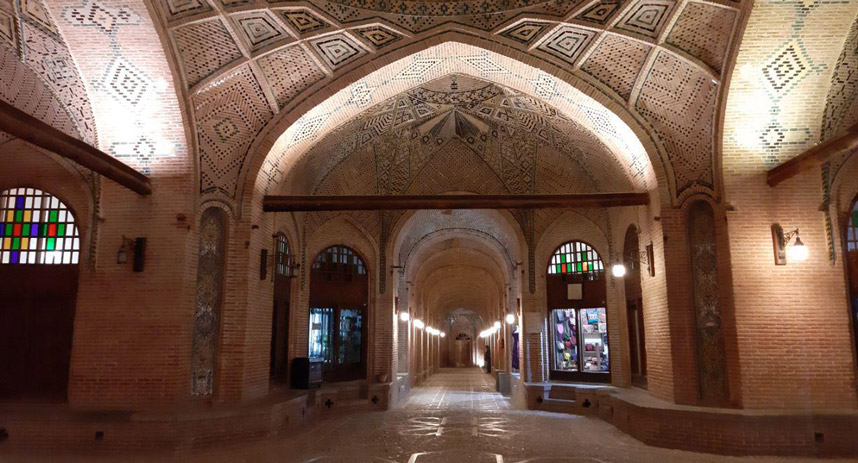Qazvin is one of the historical and developed cities of Iran.The roots of Qazvin belong to the Sassanid era which flourished on the orders of Shapur. Archeological findings in the Qazvin plain reveal the existence of urban agricultural settlements as far back as 7000 BC. Qazvin was the capital city of the Safavid Dynasty for 57 years and after the Safavid era came to an end, the city remained an important hub for trade and culture in Iran, therefore it has many historical sites and museums. In Qazvin there are various old and ancient artifacts including Qajar bath, Sardar water storage, Chehelston palace and Sepah Street which is Iran’s first street and Saad al-Saltanah caravanserai.

In the past, due to the distance between cities, it was necessary to build rest places for the passengers and their cattle, and this led to the construction of places called caravanserais or inns everywhere in Iran along the communication roads or within the cities. One of the most beautiful and famous of these buildings is Sa’ad al-Saltaneh caravanserai, which dates back to the time of Nasser al-Din Shah (who ruled from 1848 to 1896) during the Qajar era. The caravanserai of Sa’d al-Saltaneh is considered a main commercial center and reminiscent of Iranian private sector commercial development that featured trade with Europe and Russia during the Qajar era.
Mohammad Bagher Khan Saad al-Saltanah Isfahani, the ruler of Qazvin in the late Nasser al-Din Shah Qajar’s reign (1892), ordered to build a caravanserai, due to Iran’s extensive economic relations with Russia and Turkey, in a land of about 2.7 hectares with 400 chambers in the city of Qazvin and put his name on it. The construction took long two years and was finished by cooperation of two Isfahani and two Qazwini architects, in the year 1894. Until the First World War, the caravanserai was the center of commerce and business activity of the city but after the Russian government’s political changes, it lost its brisk market and businessmen gradually abandoned their stores. The historical structure lost its status as a trade bridge between Europe and Asia and its economic life continued semi-actively.
The Saad al-Saltaneh Historical Complex is one of the most valuable works of the Qajar era and one of the 38 selected monuments of Iran’s cultural heritage. The caravanserai is located in Qazvin downtown in Imam Khomeini St. near the old bazaar of Qazvin and the Chehelston palace. The moment you step into Caravanserai entrance, a journey down the history lane begins. Saad al-Saltaneh is the largest inner city caravanserai in the world and the largest inner city commercial caravanserai in Iran. It is one of the few caravansaries in Iran that has several baths, inn, arcades, series of shops, Chahar Sough (four pillars), mosque, tea house and etc. The building has several entrances, several large courtyards, numerous chambers, magnificent vestibule, long corridors, and brickwork decorations.
The caravanserai’s main entrance opens to the Imam Street, which has four arches on its sides with a roof -with no window- made in the form of skull-cap. A vestibule connects the entrance to courtyard that is surrounded with chambers decorated with little verandas. Aisles carpeted with stones and booths decorated with hundreds of years old brikes lead you to several lively courtyards.Behind the eastern chambers, there lies the large warehouse as well as the Sadieh Bathhouse. Moreover, some hujrehs or the residing rooms for the travelers are situated one meter above the courtyard ground level.Perhaps the most important part of the caravanserai is the Chahar Sough (four pillars) on top of which is a large tiled dome. The ceil of this dome has no window, and its four sides are covered by four lighted half-domes, making the space appear larger than it is.

Saad al-Saltaneh Caravanserai has been brought to more attention worldwide as it was purchased by the Cultural Heritage Organization in 1999 and recently being renovated by the municipality of Qazvin and as a result, some parts of the caravanserai give off a rather modern feeling. Currently in the context of the caravanserai, some of the chambers have been transformed into cozy places that you can enjoy cafes and restaurants in a relaxing atmosphere, beside visiting jewelry, handicrafts, carpets, paintings, and ceramics shops to buy the best souvenirs.




Customer
Truly appreciated going through this article. It’s very enlightening and structured. Great job!
Customer
This post is fantastic! Packed with valuable details and very clear. Thank you for providing this.
Customer
This article is great. I gained a lot from perusing it. The details is extremely enlightening and arranged.
Customer
Such an enlightening entry! I picked up tons from reading it. Your information is very well-organized and straightforward to follow.
Customer
Adored the insight in this entry. It’s very detailed and full of helpful details. Fantastic effort!
Customer
Genuinely appreciated going through this entry. It’s highly well-written and packed with useful information. Many thanks for sharing this.
Customer
Terrific post. It’s very articulate and full of beneficial insight. Thank you for providing this post.
Customer
Genuinely appreciated going through this post. It’s very articulate and packed with useful details. Thanks for sharing this.
Customer
This is fantastic! Full of useful information and extremely well-written. Thanks for providing this.
Customer
Truly enjoyed reading this entry. It’s extremely educational and well-organized. Great effort!
Customer
This is fantastic. I learned tons from going through it. The information is very informative and well-organized.
Customer
This post is highly educational. I really valued perusing it. The content is very structured and easy to comprehend.
Customer
Genuinely enjoyed this article. It gave tons of valuable details. Excellent job on composing this.
Customer
Really liked reading this post. It’s highly well-written and full of valuable information. Many thanks for sharing this.
Customer
This post is amazing! Filled with helpful information and highly well-written. Thanks for offering this.
Customer
Really liked this entry. It provided tons of valuable insights. Excellent job on creating this.
Customer
Excellent article. I found the information highly useful. Loved the manner you explained all the points.
Customer
This post is great. I picked up a lot from going through it. The information is extremely informative and arranged.
Customer
Fantastic article. I found the details extremely beneficial. Adored the method you clarified everything.
Customer
This is highly informative. I genuinely enjoyed perusing it. The content is extremely well-organized and simple to comprehend.
Customer
This article is great. I picked up plenty from perusing it. The details is very educational and well-organized.
Customer
Truly liked reading this article. It’s very clear and packed with valuable details. Thank you for providing this.
Customer
I have been exploring for a little for any high-quality articles or blog posts on this sort of area .
Exploring in Yahoo I finally stumbled upon this site.
Reading this information So i’m glad to exhibit that I’ve a very
just right uncanny feeling I found out just what
I needed. I so much indisputably will make certain to don?t overlook this
site and provides it a look regularly.
Customer
This article is incredibly enlightening. I really valued reading it. The details is extremely well-organized and straightforward to follow.
Customer
This post is extremely educational. I really valued perusing it. The content is extremely arranged and easy to follow.
Customer
Just have to thank you for this great information. This is what I was looking for (Thanks Bing
Customer
I went over this website and I conceive you have a lot of excellent information, saved to my bookmarks (:.
Customer
Wonderful entry. It’s highly clear and filled with valuable insight. Thank you for providing this content.
Customer
Genuinely valued this article. It provided a lot of helpful insights. Great job!
Customer
Really appreciated going through this post. It’s extremely informative and well-organized. Fantastic job!
Customer
Really enjoyed this article. It offered plenty of valuable information. Fantastic work on writing this.
Customer
Truly appreciated reading this entry. It’s highly well-written and packed with valuable insight. Thanks for providing this.
Customer
Appreciated the details in this entry. It’s very comprehensive and full of useful insights. Fantastic job!
Customer
Appreciated this post. It’s very comprehensive and packed with helpful insights. Excellent effort!
Customer
This is great. I learned a lot from reading it. The content is very enlightening and structured.
Customer
This article is extremely educational. I really valued going through it. The details is extremely well-organized and easy to follow.
Customer
Terrific post. It’s very articulate and full of beneficial details. Many thanks for offering this post.
Customer
Your insights really add depth to this topic.오피
Customer
Excellent post. I discovered the information very helpful. Loved the method you explained everything.
Customer
This post is highly enlightening. I truly valued reading it. The details is extremely arranged and simple to follow.
Customer
Your insights really add depth to this topic.오피
Customer
Really liked this article. It offered tons of helpful insights. Fantastic work on composing this.
Customer
This post is highly informative. I really appreciated reading it. The content is extremely well-organized and straightforward to understand.
Customer
This is great. I gained tons from reading it. The information is highly enlightening and structured.
Customer
This post is fantastic. I learned a lot from perusing it. The content is extremely enlightening and arranged.
Customer
Genuinely appreciated perusing this post. It’s very clear and filled with valuable insight. Thank you for sharing this.
Customer
Thanks for shening. I read many of your blog posts, cool, your blog is very good.
Customer
Loved this entry. It’s extremely comprehensive and packed with useful insights. Excellent work!
Customer
Excellent entry. I thought the content very useful. Adored the method you clarified everything.
Customer
Excellent post. It’s so well-written and filled with helpful insight. Thanks for providing this post.